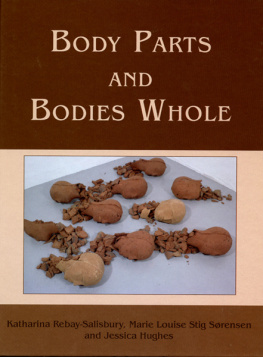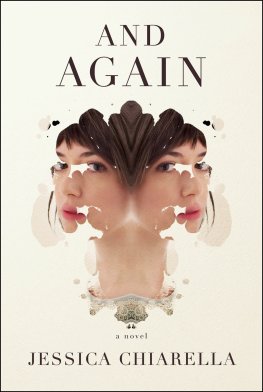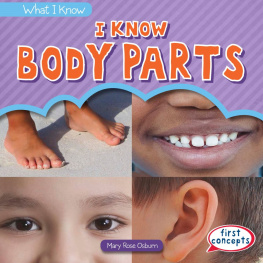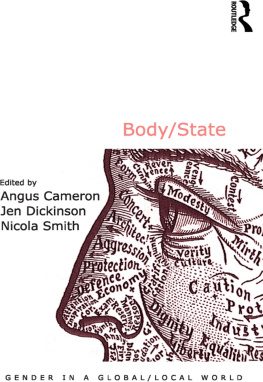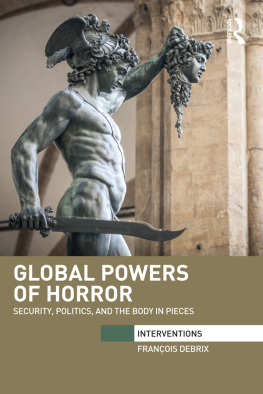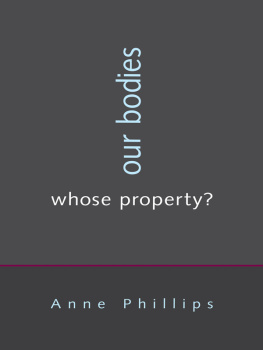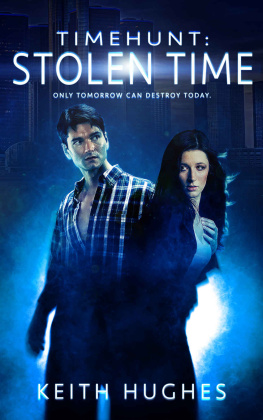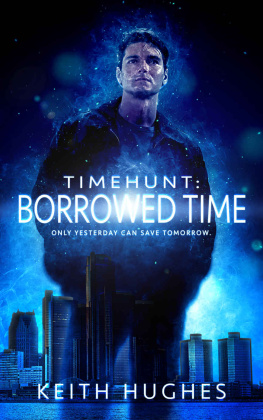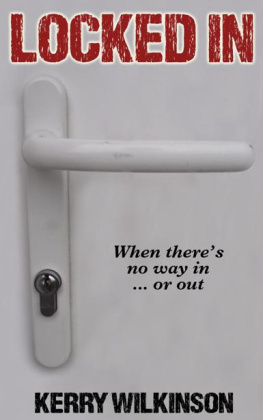Hughes Jessica. - Body Parts and Bodies Whole
Here you can read online Hughes Jessica. - Body Parts and Bodies Whole full text of the book (entire story) in english for free. Download pdf and epub, get meaning, cover and reviews about this ebook. year: 2010, publisher: Casemate Publishers & Book Distributors, LLC, genre: Religion. Description of the work, (preface) as well as reviews are available. Best literature library LitArk.com created for fans of good reading and offers a wide selection of genres:
Romance novel
Science fiction
Adventure
Detective
Science
History
Home and family
Prose
Art
Politics
Computer
Non-fiction
Religion
Business
Children
Humor
Choose a favorite category and find really read worthwhile books. Enjoy immersion in the world of imagination, feel the emotions of the characters or learn something new for yourself, make an fascinating discovery.
- Book:Body Parts and Bodies Whole
- Author:
- Publisher:Casemate Publishers & Book Distributors, LLC
- Genre:
- Year:2010
- Rating:5 / 5
- Favourites:Add to favourites
- Your mark:
- 100
- 1
- 2
- 3
- 4
- 5
Body Parts and Bodies Whole: summary, description and annotation
We offer to read an annotation, description, summary or preface (depends on what the author of the book "Body Parts and Bodies Whole" wrote himself). If you haven't found the necessary information about the book — write in the comments, we will try to find it.
Body Parts and Bodies Whole — read online for free the complete book (whole text) full work
Below is the text of the book, divided by pages. System saving the place of the last page read, allows you to conveniently read the book "Body Parts and Bodies Whole" online for free, without having to search again every time where you left off. Put a bookmark, and you can go to the page where you finished reading at any time.
Font size:
Interval:
Bookmark:
Published by
Oxbow Books, Oxford, UK
Oxbow Books, Katharina Rebay-Salisbury, Marie Louise Stig Srensen,
Jessica Hughes and the individual authors, 2010
ISBN 978-1-84217-402-9
EPUB ISBN: XXXXXXXXXXXXX
This book is available direct from:
Oxbow Books, Oxford, UK
(Phone: 01865-241249; Fax: 01865-794449)
and
The David Brown Book Company
PO Box 511, Oakville, CT 06779, USA
(Phone: 860-945-9329; Fax: 860-945-9468)
or from our website
www.oxbowbooks.com
Cover image
Ex-Votos - Men and Women by Christie Brown 2003
Photograph: Kate Forrest
A CIP record for this book is available from the British Library
Library of Congress Cataloging-in-Publication Data
Body parts and bodies whole : changing relations and meanings / edited by Katharina Rebay-Salisbury, Marie Louise Stig
Srensen, and Jessica Hughes.
p. cm.
ISBN 978-1-84217-402-9
1. Human remains (Archaeology)--Europe. 2. Human remains (Archaeology)--Middle East. 3. Human body--Social aspects--Europe. 4.
Human body--Social aspects--Middle East. 5. Europe--Antiquities. 6. Middle East--Antiquities. I. Rebay-Salisbury, Katharina. II. Srensen,
Marie Louise Stig. III. Hughes, Jessica.
CC79.5.H85B63 2010
930.1--dc22
2010022047
Printed and bound in Great Britain by
Short Run Press, Exeter
Contents
|
|
|
|
|
|
|
|
|
|
|
|
|
Cover Acknowledgement
Ex-Votos 2003
In Ex-Votos Men and Women the heads are filled with the shards of past abandoned works, now destroyed as whole entities but reduced to indestructible fragments, which contain evidence of histories and memories. This work, which developed into a larger scale floor piece, made reference to the ancient practice of gifts to the gods in exchange for healing and was informed by an interest in the parallels between archaeology and psychoanalysis where layers are carefully stripped away to uncover knowledge. Referencing the cataloguing and classification of museum artefacts, each head was marked in black with dollar or yens signs to indicate their timeless worth and the making method of casting and press moulding refers to the patterns and repetitions in human life. Ex-Votos was part of a larger series of work entitled Between the Dog and the Wolf which explored metamorphoses and change.
Christie Brown
1. Body Parts and Bodies Whole: Introduction
Katharina Rebay-Salisbury, Marie Louise Stig Srensen and Jessica Hughes
Several human heads lay in the corner of a room, surrounded by small ceramic fragments, their necks broken (). The viewer who chances upon this scene is immediately implicated in formulating a narrative. When and how were these ceramic heads shattered? Was it an accident, or an intentional act of violence? On closer inspection, the heads seem to have been carefully and deliberately arranged: their blank gazes follow the same axis of vision, while the smaller terracotta fragments are gathered into neat little piles at the bases of their necks hinting at the former existence of more parts. This trace of an unseen agent intensifies the viewers search for meaning. Who do these heads represent? What relationship do they bear to one another? Our impulse to identify individual portraits is renounced by the identical clay faces, each of which wears the same benign expression. The message that the heads communicate is that they belong together: they are parts of the (whole) group, as much as they are parts of the (absent) bodies from which they have apparently been removed.

Fig. 1.1: Ex-Votos Men and Women (detail; photo courtesy of Christie Brown).
This intriguing scene is the creation of Christie Brown, a London-based artist whose sculptures engage with archaeology, mythology and psychoanalysis. Browns description of the work reveals how both the heads and smaller fragments recall or literally embody past objects and practices:
In Ex-Votos Men and Women the heads are filled with the shards of past abandoned works, now destroyed as whole entities but reduced to indestructible fragments, which contain evidence of histories and memories. This work, which developed into a larger scale floor piece, made reference to the ancient practice of gifts to the gods in exchange for healing and was informed by an interest in the parallels between archaeology and psychoanalysis where layers are carefully stripped away to uncover knowledge. Referencing the cataloguing and classification of museum artefacts, each head was marked in black with dollar or yen signs to indicate their timeless worth and the making method of casting and press moulding refers to the patterns and repetitions in human life. Ex-Votos was part of a larger series of work entitled Between the Dog and the Wolf which explored metamorphoses and change (Christie Brown, pers. comm.).
This piece of contemporary art caught our attention because it dramatises a number of the themes that we wanted to investigate in this volume on body parts and bodies whole. Archaeologists routinely encounter parts of human and animal bodies in their excavations, as well as broken inorganic material. Such fragmentary evidence has often been created through accidental damage and the passage of time nevertheless, it can also signify a deliberate and meaningful act of fragmentation. ).
Within archaeology, John Chapmans work in particular has been concerned with the relationship between parts and whole. In his exploration of the relationship between whole and fragmented objects in the Balkan Neolithic (Chapman 2000), he suggested an interpretation of fragmentation in which social relations are built through a process of enchainment. This theory posits that the breaking of an object does not automatically entail its loss; on the contrary, the parts of the broken object can become independently meaningful and play a role in a variety of contexts. For instance, the distribution of parts of things or bodies between people can function as a marker of social relations. This echoes work on dividual personhood, in particular the hugely influential work of Marilyn Strathern (1988). With Bisserka Gaydarska, John Chapman expanded his work on artefact fragmentation by further exploring the biography of objects and their lifecycle in the monograph Parts and wholes (2007). Meanwhile, in comparison with the fragmentation of objects, the relationship between body parts and body wholes seems to introduce new dimensions to the ways people and things may be enchained. In particular, the impact of the life cycle including death and the challenges of the changeable body may inspire the construction of different conceptional frameworks which aim to confirm the character of the body or help in its transformation. From history and ethnography we have a wide range of examples showing how the body can be physically partitioned and transformed, how body parts may stand metonymically for whole bodies, or how parts may still be symbolically linked even when they are separated, or alternatively, how parts may be differentiated and their links to the whole severed. In all cases, body parts lose their original function when disarticulated from the whole, but at the same time they can acquire new meanings and significances.
Next pageFont size:
Interval:
Bookmark:
Similar books «Body Parts and Bodies Whole»
Look at similar books to Body Parts and Bodies Whole. We have selected literature similar in name and meaning in the hope of providing readers with more options to find new, interesting, not yet read works.
Discussion, reviews of the book Body Parts and Bodies Whole and just readers' own opinions. Leave your comments, write what you think about the work, its meaning or the main characters. Specify what exactly you liked and what you didn't like, and why you think so.

